7.4: Hydropower
- Page ID
- 69430
\( \newcommand{\vecs}[1]{\overset { \scriptstyle \rightharpoonup} {\mathbf{#1}} } \)
\( \newcommand{\vecd}[1]{\overset{-\!-\!\rightharpoonup}{\vphantom{a}\smash {#1}}} \)
\( \newcommand{\dsum}{\displaystyle\sum\limits} \)
\( \newcommand{\dint}{\displaystyle\int\limits} \)
\( \newcommand{\dlim}{\displaystyle\lim\limits} \)
\( \newcommand{\id}{\mathrm{id}}\) \( \newcommand{\Span}{\mathrm{span}}\)
( \newcommand{\kernel}{\mathrm{null}\,}\) \( \newcommand{\range}{\mathrm{range}\,}\)
\( \newcommand{\RealPart}{\mathrm{Re}}\) \( \newcommand{\ImaginaryPart}{\mathrm{Im}}\)
\( \newcommand{\Argument}{\mathrm{Arg}}\) \( \newcommand{\norm}[1]{\| #1 \|}\)
\( \newcommand{\inner}[2]{\langle #1, #2 \rangle}\)
\( \newcommand{\Span}{\mathrm{span}}\)
\( \newcommand{\id}{\mathrm{id}}\)
\( \newcommand{\Span}{\mathrm{span}}\)
\( \newcommand{\kernel}{\mathrm{null}\,}\)
\( \newcommand{\range}{\mathrm{range}\,}\)
\( \newcommand{\RealPart}{\mathrm{Re}}\)
\( \newcommand{\ImaginaryPart}{\mathrm{Im}}\)
\( \newcommand{\Argument}{\mathrm{Arg}}\)
\( \newcommand{\norm}[1]{\| #1 \|}\)
\( \newcommand{\inner}[2]{\langle #1, #2 \rangle}\)
\( \newcommand{\Span}{\mathrm{span}}\) \( \newcommand{\AA}{\unicode[.8,0]{x212B}}\)
\( \newcommand{\vectorA}[1]{\vec{#1}} % arrow\)
\( \newcommand{\vectorAt}[1]{\vec{\text{#1}}} % arrow\)
\( \newcommand{\vectorB}[1]{\overset { \scriptstyle \rightharpoonup} {\mathbf{#1}} } \)
\( \newcommand{\vectorC}[1]{\textbf{#1}} \)
\( \newcommand{\vectorD}[1]{\overrightarrow{#1}} \)
\( \newcommand{\vectorDt}[1]{\overrightarrow{\text{#1}}} \)
\( \newcommand{\vectE}[1]{\overset{-\!-\!\rightharpoonup}{\vphantom{a}\smash{\mathbf {#1}}}} \)
\( \newcommand{\vecs}[1]{\overset { \scriptstyle \rightharpoonup} {\mathbf{#1}} } \)
\( \newcommand{\vecd}[1]{\overset{-\!-\!\rightharpoonup}{\vphantom{a}\smash {#1}}} \)
\(\newcommand{\avec}{\mathbf a}\) \(\newcommand{\bvec}{\mathbf b}\) \(\newcommand{\cvec}{\mathbf c}\) \(\newcommand{\dvec}{\mathbf d}\) \(\newcommand{\dtil}{\widetilde{\mathbf d}}\) \(\newcommand{\evec}{\mathbf e}\) \(\newcommand{\fvec}{\mathbf f}\) \(\newcommand{\nvec}{\mathbf n}\) \(\newcommand{\pvec}{\mathbf p}\) \(\newcommand{\qvec}{\mathbf q}\) \(\newcommand{\svec}{\mathbf s}\) \(\newcommand{\tvec}{\mathbf t}\) \(\newcommand{\uvec}{\mathbf u}\) \(\newcommand{\vvec}{\mathbf v}\) \(\newcommand{\wvec}{\mathbf w}\) \(\newcommand{\xvec}{\mathbf x}\) \(\newcommand{\yvec}{\mathbf y}\) \(\newcommand{\zvec}{\mathbf z}\) \(\newcommand{\rvec}{\mathbf r}\) \(\newcommand{\mvec}{\mathbf m}\) \(\newcommand{\zerovec}{\mathbf 0}\) \(\newcommand{\onevec}{\mathbf 1}\) \(\newcommand{\real}{\mathbb R}\) \(\newcommand{\twovec}[2]{\left[\begin{array}{r}#1 \\ #2 \end{array}\right]}\) \(\newcommand{\ctwovec}[2]{\left[\begin{array}{c}#1 \\ #2 \end{array}\right]}\) \(\newcommand{\threevec}[3]{\left[\begin{array}{r}#1 \\ #2 \\ #3 \end{array}\right]}\) \(\newcommand{\cthreevec}[3]{\left[\begin{array}{c}#1 \\ #2 \\ #3 \end{array}\right]}\) \(\newcommand{\fourvec}[4]{\left[\begin{array}{r}#1 \\ #2 \\ #3 \\ #4 \end{array}\right]}\) \(\newcommand{\cfourvec}[4]{\left[\begin{array}{c}#1 \\ #2 \\ #3 \\ #4 \end{array}\right]}\) \(\newcommand{\fivevec}[5]{\left[\begin{array}{r}#1 \\ #2 \\ #3 \\ #4 \\ #5 \\ \end{array}\right]}\) \(\newcommand{\cfivevec}[5]{\left[\begin{array}{c}#1 \\ #2 \\ #3 \\ #4 \\ #5 \\ \end{array}\right]}\) \(\newcommand{\mattwo}[4]{\left[\begin{array}{rr}#1 \amp #2 \\ #3 \amp #4 \\ \end{array}\right]}\) \(\newcommand{\laspan}[1]{\text{Span}\{#1\}}\) \(\newcommand{\bcal}{\cal B}\) \(\newcommand{\ccal}{\cal C}\) \(\newcommand{\scal}{\cal S}\) \(\newcommand{\wcal}{\cal W}\) \(\newcommand{\ecal}{\cal E}\) \(\newcommand{\coords}[2]{\left\{#1\right\}_{#2}}\) \(\newcommand{\gray}[1]{\color{gray}{#1}}\) \(\newcommand{\lgray}[1]{\color{lightgray}{#1}}\) \(\newcommand{\rank}{\operatorname{rank}}\) \(\newcommand{\row}{\text{Row}}\) \(\newcommand{\col}{\text{Col}}\) \(\renewcommand{\row}{\text{Row}}\) \(\newcommand{\nul}{\text{Nul}}\) \(\newcommand{\var}{\text{Var}}\) \(\newcommand{\corr}{\text{corr}}\) \(\newcommand{\len}[1]{\left|#1\right|}\) \(\newcommand{\bbar}{\overline{\bvec}}\) \(\newcommand{\bhat}{\widehat{\bvec}}\) \(\newcommand{\bperp}{\bvec^\perp}\) \(\newcommand{\xhat}{\widehat{\xvec}}\) \(\newcommand{\vhat}{\widehat{\vvec}}\) \(\newcommand{\uhat}{\widehat{\uvec}}\) \(\newcommand{\what}{\widehat{\wvec}}\) \(\newcommand{\Sighat}{\widehat{\Sigma}}\) \(\newcommand{\lt}{<}\) \(\newcommand{\gt}{>}\) \(\newcommand{\amp}{&}\) \(\definecolor{fillinmathshade}{gray}{0.9}\)Hydropower (hydroelectric energy) refers to the energy in moving water, which can be used to generate electricity. It is ultimately driven by solar energy. Water at high elevations is replenished through evaporation (induced by solar heat), condensation, and precipitation. The moving water turns a turbine (figure \(\PageIndex{1}\)) and this moves magnets within a wire coil, causing the movement of electrons in a generator. The result is an electric current (electricity). Combustion of fossil fuels or biofuels, nuclear energy, wind energy, and thermal solar systems all follow this same general mechanism; the difference is what causes the turbine to spin.
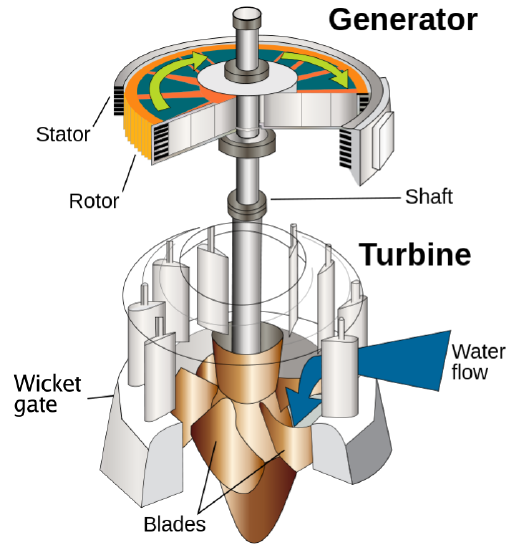
Figure \(\PageIndex{1}\): A water turbine. Moving water turns the blades of the turbine. The wicket gate controls the water flow. The moving water causes magnets in the rotor to spin and move electrons within the loops of wire in the stator, generating an electric current. Image by U.S. Army Corps of Engineers (public domain).
There are several types of hydropower, but each generates electricity through the same general mechanism described above. The most well-known use of hydropower involves dams. Dams block the flow of rivers, producing an artificial lake (reservoir) upstream. The release of water is then controlled. Some of this water moves through a channel (penstock), and this kinetic energy (energy of motion) is harnessed into electricity (figure \(\PageIndex{2}\)).
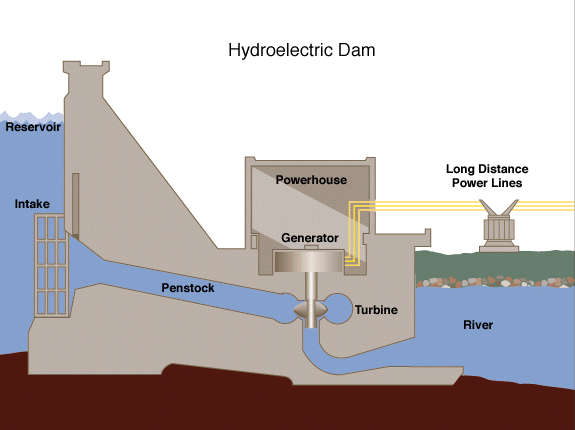
Figure \(\PageIndex{2}\): A section of a hydroelectric dam. Water in the reservoir passes through the intake into the penstock, which is a narrow channel. The moving water turns a turbine. This powers the generator in the powerhouse. The water continues down the river. Meanwhile electricity is distributed through long distance power lines. Image by Tennessee Valley Authority (public domain).
Because water is stored in a reservoir for large-scale hydropower systems with dams, these facilities have a large effect on river flow below the dam. This kind of facility has a large effect on the seasonal variation of below-dam riverflow, because it greatly reduces the spring peak flow while increasing the flow during the summer, fall, and winter (Figure \(\PageIndex{3}\)).
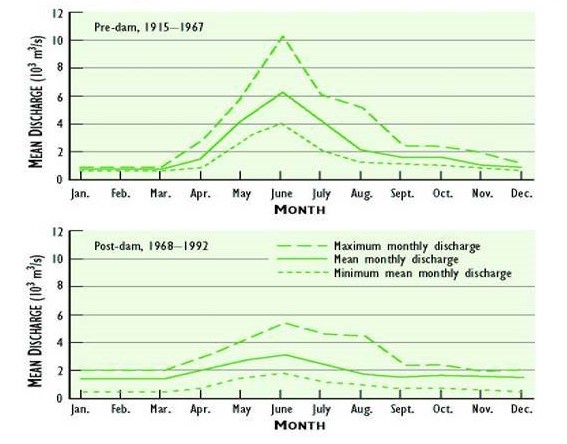
Figure \(\PageIndex{3}\): Effects of Reservoir Development on Seasonal Flow of the Peace River. The Bennett Dam and its associated reservoir were built in 1968, so the upper curves (for 1915–1967) represent pre-impoundment conditions. The flows were measured at the town of Peace River, Alberta. The most notable changes are (1) an overall reduction in the annual variation of riverflow; (2) a large reduction in peak flow during mid-April to mid-July; and (3) an increase during the low-flow period of September to March. Source: Modified from Rosenberg et al. (1997) by Bill Freedman.
In so-called peaking or hydropeaking systems water flow below the dam is altered throughout the day to increase flow of water (and therefore electricity generation) at times when demand for electricity is high and decrease flow of water at times when demand for electricity is lower (Figure \(\PageIndex{4}\)). If the peak-flow system causes large flow variations downriver, important ecological damage may be caused.
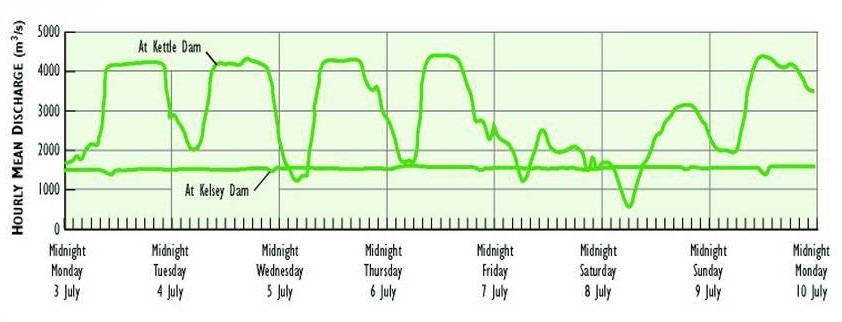
Figure \(\PageIndex{4}\): Effects of Peaking Discharges on Hourly Mean Discharge to the Nelson River. The data are for a one-week period in July 1984. This figure illustrates the changes in hydrology that occur downstream if the generation of electricity is timed to meet the peak daily demand. Note the relatively low demand during the weekend. Kelsey Dam is not subject to these peaking discharges, so it represents the background pattern of low flow in the summer. Source: Modified from Rosenberg et al. (1997) by Bill Freedman
Hydropower dams and the reservoirs they create degrades habitat and negatively impacts native species. For example, migration of fish to their upstream spawning areas can be obstructed by dams. In areas where salmon must travel upstream to spawn, such as along the Columbia River in Washington and Oregon, the dams block their way (figure \(\PageIndex{5}\)). This problem can be partially alleviated by using “fish ladders” that help salmon get around the dams (figure \(\PageIndex{6}\)). Fish traveling downstream, however, can get killed or injured as water moves through turbines in the dam. Reservoirs and operation of dams can also affect aquatic habitats due to changes in water temperatures, water depth, chemistry, flow characteristics, and sediment loads, all of which can lead to significant changes in the ecology and physical characteristics of the river both upstream and downstream. When reservoirs first fill with water, they inundate terrestrial (land) habitats, farms, cities, and archeological and cultural sites, sometimes forcing populations to relocate. The terrestrial vegetation slowly decomposes in oxygen-poor conditions, releasing methane into the atmosphere, a potent greenhouse gas. In this sense, hydropower generates few air pollutants during operation, but construction does contribute to climate change.

Figure \(\PageIndex{5}\): The Grand Coulee Dam on the Columbia River in Washington state created Lake Roosevelt, which provides outdoor recreation such as fishing and swimming. However, it compromised salmon populations and flooded sacred sites for people of the Spokane Tribe. Image by U.S. Bureau of Reclamation (public domain).
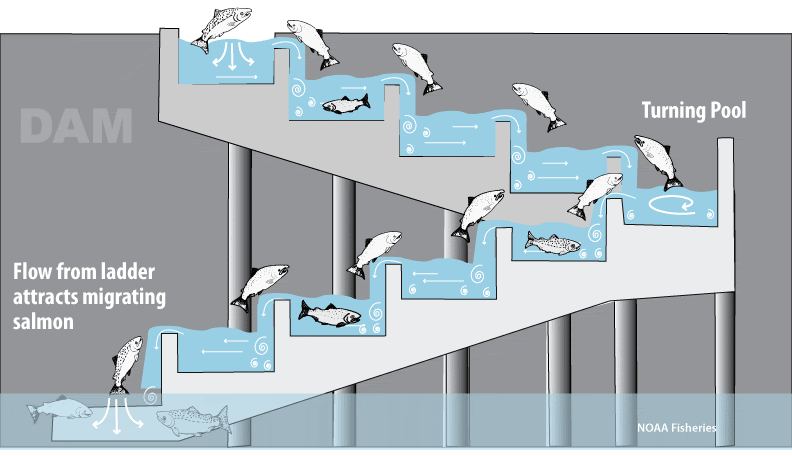
Figure \(\PageIndex{6}\): Left: The fish ladder at John Day Lock and Dam along the Columbia River in Oregon allows adult fish to migrate upstream of the dam on their own. Right: Diagram of a fish ladder, which allows the passage of salmon over a dam. Salmon swim upstream to spawn (reproduce) and are able to swim up the steps of the ladder. The flow from the ladder attracts migrating salmon. At the turning pool, they rotate and then proceed up the next flight of the ladder until they are over the dam. Left image and caption (modified) from U.S. Army Corps of Engineers, and right image by NOAA Fisheries (public domain).
Large-scale dam hydropower projects are often criticized for their impacts on wildlife habitat, fish migration, and water flow and quality. However, small run-of- the-river projects are free from many of the environmental problems associated with their large-scale relatives because they use the natural flow of the river, and thus produce relatively little change in the stream channel and flow. In run-of-the-river hydroelectricity, the turbine is placed directly into a river, and the natural flow of water through the river spins the turbine. The dams built for some run-of-the-river projects are very small and impound little water, and many projects do not require a dam at all. Thus, effects such as oxygen depletion, increased temperature, decreased flow, and impeded upstream migration are not problems for many run-of-the-river projects.
Small hydropower projects offer power solutions for many remote communities throughout the world, such as those in Nepal, India, China, and Peru, as well as for highly industrialized countries like the United States. Small hydropower systems are those that have a capacity between 0.01 to 30 megawatt (MW) of power. For reference, a 1-MW generator operating for an hour (producing 1 MWh) generates enough electricity to powers the average home in the U.S. for a little over a month. Small hydropower systems that generate less than 0.1 MW are more specifically called microhydropower systems (figure \(\PageIndex{7}\)). Most of the systems used by home and small business owners would qualify as microhydropower systems. In fact, a 10 kW system generally can provide enough power for a large home, a small resort, or a hobby farm.
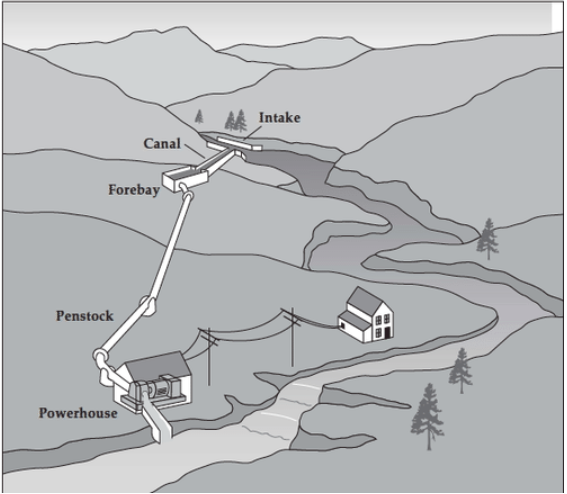
Figure \(\PageIndex{7}\): A microhydropower system. Although there are several ways to harness the moving water to produce energy, run-of-the-river systems, which do not require large storage reservoirs, are often used for microhydropower projects. For run-of-the-river hydro projects, a portion of a river’s water is diverted to a channel, pipeline, or pressurized pipeline (penstock) that delivers it to a waterwheel or turbine. In this image, water from the river moves through the intake then to the canal, forebay, penstock, and powerhouse, which contains the turbine. The moving water rotates the wheel or turbine, which spins a shaft. The motion of the shaft can be used for mechanical processes, such as pumping water, or it can be used to produce electricity. In this image, electrical lines connect the powerhouse to a nearby house.
One benefit of using hydropower is that dams and reservoirs can additionally be used for recreation, flood control, and storing freshwater. While we will never run out of moving water, the potential to use hydropower fluctuates based on precipitation. For example, during a drought, water levels in a reservoir decreases, and there is less water released to generate electricity. As with most sources of renewable energy, hydropower is not practical everywhere, and it is most effective in mountainous regions with high rainfall and snowmelt.
Tidal energy and energy from ocean waves (figure \(\PageIndex{8}\)) are also considered forms of hydropower. However, tidal energy arises from the gravitational attraction of the moon and the more distant sun on the earth’s oceans, combined with rotation of the earth. In other words, most forms of hydropower are indirect forms of solar energy, with the exception of tidal energy.
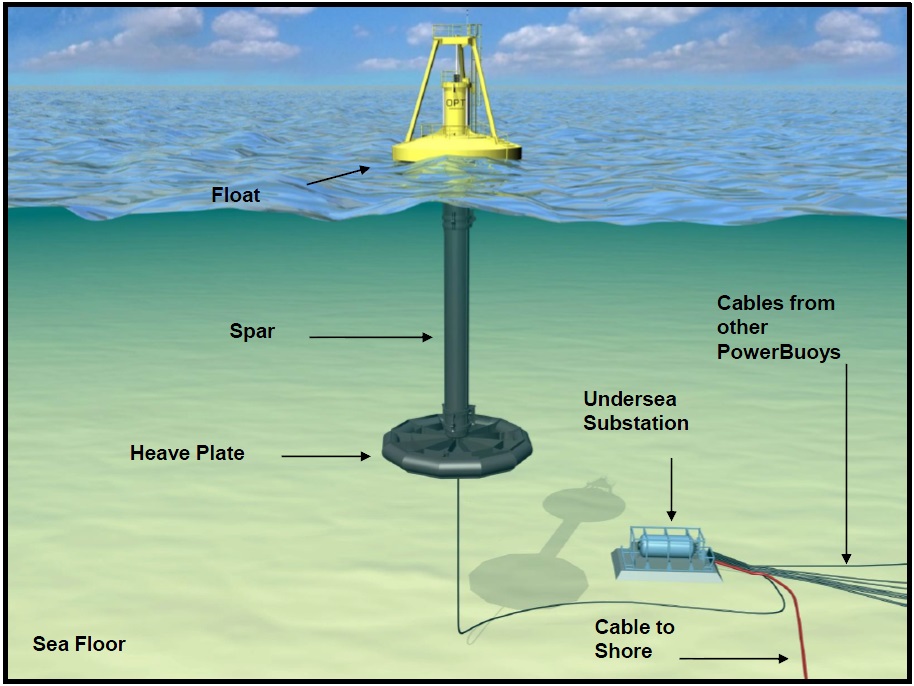
Figure \(\PageIndex{8}\): One way to harness wave energy is with an absorber. Absorbers extract energy from the rise and fall of the waves with a buoy. The buoy consists of the float, which is above the water and a heavy plate. The narrow spar connects the two. A cable connects the heavy plate of each buoy to an undersea substation, and another cable runs from the substation to the shore. Image and caption (modified) by OpenEI (public domain).
Contributors and Attributions
Modified by Kyle Whittinghill and Melissa Ha from the following sources:
- Renewable Energy and Challenges and Impacts of Energy Use from Environmental Biology by Matthew R. Fisher (licensed under CC-BY)
- Essentials of Environmental Science by Kamala Doršner is licensed under CC BY 4.0.
- Additional Problems of Surface Waters from Environmental Science: A Canadian Perspective by Bill Freedman.


